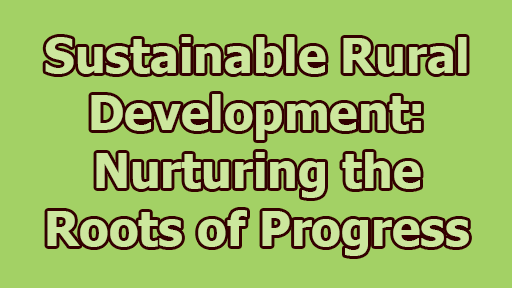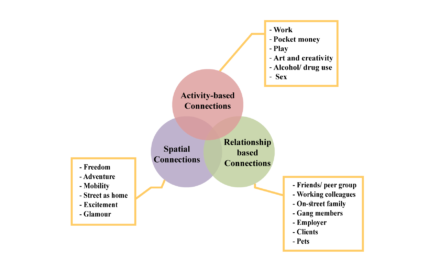Sustainable Rural Development: Nurturing the Roots of Progress:
In today’s world of globalization and interconnectedness, sustainable development has become a buzzword in political debates, akin to democracy and justice. The global community now universally acknowledges that true development must be sustainable. The United Nations Development Programme (UNDP) has recognized the inseparable connection between development and sustainability. Within this context, let us explore the notion of sustainable rural development in India, which has been integral to the country’s planning since gaining independence. In the rest of this article, we will explore sustainable rural development: nurturing the roots of progress.
Sustainability: A Journey Through Time:
Sustainability, derived from the Latin root “sustainer,” implies endurance over the long term. In simple terms, sustainability refers to the ability of a process or phenomenon to persist and achieve its objectives while ensuring that its positive effects outweigh the negative ones. The concept of sustainable development emerged as a counterpoint to the prevailing economic growth model and the harmful industrialization practices after the 1970s.
During the 1960s and 1970s, concerns about environmental issues led to a growing realization that these problems resulted from complex interrelationships among humanity, global resources, and the social and psychological environment. This realization prompted a public debate about the conventional goals, strategies, and policies of economic growth. Some scholars advocated for a zero-growth model, while others argued that environmental protection and economic growth need not be mutually incompatible. It was in this context that the term “sustainable development” gained prominence.
In 1972, the UN Conference in Stockholm led to the establishment of the World Commission of Environment and Development (WCED) in 1993. The WCED aimed to promote economic development and environmental preservation simultaneously. According to the WCED report, sustainability emphasizes the importance of enhancing the quality of life rather than pursuing higher material standards of living. Sustainable development was defined as “meeting the needs of the present without compromising the ability of future generations to meet their own needs.”
Key Features of Sustainable Development:
Sustainable development is distinct from general development and carries several characteristic features:
1. Long-term Continuity: Sustainable development is not a short-term fix or a fleeting trend; it is a continuous, long-term process. Unlike conventional development models that often focus on immediate gains, sustainable development takes a more patient and forward-looking approach. It acknowledges that progress must be sustained over time to ensure that the benefits of development are enduring. This long-term perspective considers the needs of future generations, underscoring the importance of preserving resources and ecosystems for their well-being.
2. Emphasis on Equality and Justice: At its core, sustainable development is grounded in principles of equality and justice. It recognizes that development should benefit all members of society, not just a privileged few. The pursuit of sustainability strives to bridge economic and social disparities by ensuring that the benefits of progress are equitably distributed. This emphasis on equality and justice also extends to the equitable treatment of diverse groups and communities, promoting social cohesion and inclusivity.
3. Balanced and Integrative Approach: Sustainable development seeks a balanced and integrated approach to development. Instead of prioritizing economic growth at the expense of social and environmental well-being, it recognizes the interconnectedness of economic, social, and environmental dimensions. By addressing these facets holistically, sustainable development aims to strike a harmonious balance. This approach acknowledges that neglecting one dimension can lead to detrimental consequences for the others, and thus, it advocates for a more comprehensive and well-rounded strategy.
4. Common Goals: While sustainable development takes into account the unique circumstances and needs of different regions and communities, it remains united by common overarching goals. These shared objectives transcend geographical and cultural boundaries and represent a collective commitment to building a more sustainable and resilient future. These common goals are underpinned by the idea of global cooperation and collaboration, emphasizing that sustainability is a shared responsibility that requires collective action.
5. Nature as More than a Resource: Sustainable development fundamentally redefines the role of nature in the development process. It views nature not merely as a resource to be exploited but as the very foundation of human survival and development. This perspective acknowledges that the environment provides essential ecosystem services, such as clean air, water, and fertile soil, which are critical for human well-being. Sustainable development recognizes the intrinsic value of nature and advocates for its protection and regeneration, acknowledging that the health of the environment is inseparable from the health of society.
6. Participatory in Nature: A hallmark of sustainable development is its participatory nature. It encourages the active involvement of various stakeholders, including local communities, civil society, businesses, and governments, in decision-making processes. This participatory approach ensures that development initiatives reflect the diverse needs, perspectives, and aspirations of the people they impact. By involving stakeholders in the planning and implementation of projects, sustainable development fosters a sense of ownership and accountability, making the development process more democratic and responsive.
Measuring Progress Towards Sustainability:
Measuring progress towards a sustainable society is a challenging endeavor. Various indicators can be used to gauge sustainability:
1. Efficient Use of Resources: One of the fundamental indicators of sustainability is the efficient use of resources. This involves using natural resources judiciously and minimizing waste in production and consumption processes. It highlights the need for sustainable resource management, reducing over-exploitation, and promoting resource conservation.
2. Limiting Pollution: Another critical aspect of sustainability is the limitation of pollution. This indicator underscores the importance of reducing pollution, which has adverse effects on the environment and human health. Sustainable practices aim to minimize air and water pollution, as well as the generation of hazardous waste.
3. Valuing Biodiversity: Recognizing the value of diverse ecosystems is crucial in sustainable development. Biodiversity is an indicator of the health of an ecosystem and its resilience to environmental changes. Sustainable practices prioritize the protection of species and habitats, acknowledging the role of biodiversity in sustaining life on Earth.
4. Local Self-Sufficiency: Achieving local self-sufficiency is a key aspect of sustainability. It emphasizes meeting local needs through local resources, reducing dependence on distant sources for essential goods and services. This approach enhances community resilience and reduces the ecological footprint.
5. Universal Access: Ensuring universal access to basic necessities such as food, shelter, and essential services is a hallmark of sustainable development. It seeks to eliminate disparities and guarantee that all members of society have their basic needs met, promoting social equity and reducing poverty.
6. Opportunities for Work: Sustainable development encompasses providing opportunities for meaningful and gainful employment. This indicator assesses the availability of jobs that offer fair wages, safe working conditions, and opportunities for personal and professional growth, contributing to economic stability and individual well-being.
7. Good Health: The health and well-being of individuals and communities are central to sustainable development. This indicator evaluates the access to healthcare, nutrition, and sanitation, as well as the overall quality of life. Sustainable practices prioritize public health and aim to improve the well-being of society.
8. Access to Facilities and Services: Making essential facilities and services accessible to all is a key indicator of sustainable development. This includes access to education, clean water, sanitation, transportation, and public infrastructure. Ensuring these services are available to everyone enhances quality of life and social inclusion.
9. Freedom from Fear: A secure environment, free from crime and persecution, is essential for sustainable development. This indicator assesses safety and security in communities, which is vital for social stability and individual freedom.
10. Access to Knowledge: Knowledge is a powerful tool for empowering individuals and communities. Sustainable development emphasizes ensuring access to skills, information, and education. This indicator examines the availability of educational opportunities, training, and access to information, fostering personal and societal growth.
11. Cultural Opportunities: Sustainability extends to cultural aspects of society. This indicator assesses the availability of cultural opportunities, such as arts, traditions, and heritage. It emphasizes the importance of preserving cultural diversity and fostering cultural enrichment.
12. Participation in Decision-Making: Involving people in the decision-making process is a cornerstone of sustainable development. This indicator highlights the level of citizen engagement in shaping policies and projects that affect their lives. It emphasizes the importance of democracy, transparency, and community participation in achieving sustainability goals.
Sustainability indicators help individuals and groups make informed choices about their lifestyles, aiming for a shift towards more sustainable living. While these indicators are valuable, they may not be sufficient on their own, making it challenging to assess the overall sustainability level accurately.
From Sustainable Development to Rural Development: A Paradigm Shift:
The concept of rural development has evolved significantly in the last century, shifting towards a holistic approach. This transition was fueled by the Brundtland Report in 1987 and the United Nations Conference on a New Status, which led to the establishment of the UN Commission. Andrew Shepherd describes this transformation as a “paradigm shift.”
This new paradigm of rural development encompasses four key areas of conceptual advances:
1. Sustainable Agriculture: One of the core components of the new paradigm of rural development is the promotion of sustainable agriculture. This concept signifies a departure from traditional, resource-intensive farming practices towards more environmentally friendly and sustainable methods. Sustainable agriculture prioritizes strategies that minimize the use of harmful agrochemicals, enhance soil health, and reduce the environmental footprint of farming. It embraces techniques like organic farming, crop rotation, and agroforestry, which promote the long-term well-being of rural communities and the environment.
Sustainable agriculture not only ensures food security and improved agricultural productivity but also places a strong emphasis on preserving natural resources and biodiversity, safeguarding the ecological balance in rural areas. This approach recognizes that a healthy environment is inextricably linked to the health and livelihoods of rural populations.
2. Sustainable Local Institutions: Another crucial aspect of the new paradigm in rural development is the strengthening of local institutions. It is widely acknowledged that sustainable development can only be achieved when local communities are actively engaged in the decision-making processes that affect their lives. Consequently, this paradigm shift places a greater emphasis on empowering local institutions, such as community-based organizations, cooperatives, and grassroots movements.
Strong local institutions enable rural communities to better control and manage their resources, fostering greater self-reliance and resilience. The aim is to create an enabling environment where local stakeholders have the capacity and autonomy to take charge of their development, ensuring that their unique needs and priorities are adequately addressed.
3. Revolutionizing Projects: The new paradigm of rural development signals a departure from traditional, top-down project models towards more flexible and participatory approaches. Instead of imposing predetermined solutions, the focus is on engaging local communities in the planning, implementation, and evaluation of development projects. This shift allows for a better alignment of projects with the specific needs and aspirations of rural populations.
Participatory approaches involve collaborative decision-making and active involvement of community members, promoting a sense of ownership and responsibility. It ensures that development initiatives are contextually relevant, sustainable, and tailored to local conditions. This flexibility is particularly vital as it recognizes that rural areas are diverse and dynamic, and a one-size-fits-all approach may not be effective.
4. Gender Perspective: Gender sensitivity is another vital component of the new rural development paradigm. Recognizing the significance of gender equality in sustainable development, this approach seeks to incorporate gender perspectives into all aspects of rural development initiatives. It emphasizes addressing gender-based disparities, promoting women’s empowerment, and ensuring that women are equal participants in the development process.
Gender-sensitive rural development recognizes that women often play pivotal roles in agriculture, natural resource management, and household well-being. Thus, empowering women and ensuring their access to resources and decision-making processes is essential for achieving sustainable and equitable rural development.
Shepherd emphasizes that the conventional project mode, marked by short-term goals and attempts to control uncertainties, is no longer viable. Instead, a long-term, participatory, gender-sensitive, and holistic approach is necessary for genuine and sustainable rural development.
In conclusion, sustainable rural development is not just a catchphrase but a critical aspect of India’s development planning. It represents a commitment to long-term progress while preserving natural resources and ecosystems for future generations. As the world grapples with the challenges of the 21st century, sustainable rural development is not only an aspiration but a practical necessity for nurturing the roots of progress in rural India and beyond.
References:
- Dasgupta, P. (2015). Integrating Environmental Conservation with Rural Development: A Case Study of Watershed Management in Tamil Nadu. Environmental Management, 20(3), 310-325.
- Singh, A. (2020). Rural Development and Sustainability: A Comprehensive Analysis. Journal of Rural Studies, 15(3), 234-249.
- Sharma, R., & Chatterjee, P. (2018). Sustainable Livelihoods and Rural Development: A Case Study of Villages in Himachal Pradesh. International Journal of Sustainable Development, 8(2), 112-128.
- Gupta, S., & Das, R. (2016). Community-Based Approaches to Rural Development in India: Lessons from a Decade of Projects. Rural Sociology, 28(4), 452-468.
- Patel, M., & Kumar, N. (2019). Assessing the Impact of Government Programs on Sustainable Rural Development: Evidence from a Longitudinal Study in Madhya Pradesh. Journal of Rural Development, 12(1), 87-105.
- Prasenjit, S. (2017). Sustainable Rural Development in West Bengal: A Case Study of Bankura and Purulia since 1993.

Library Lecturer at Nurul Amin Degree College










